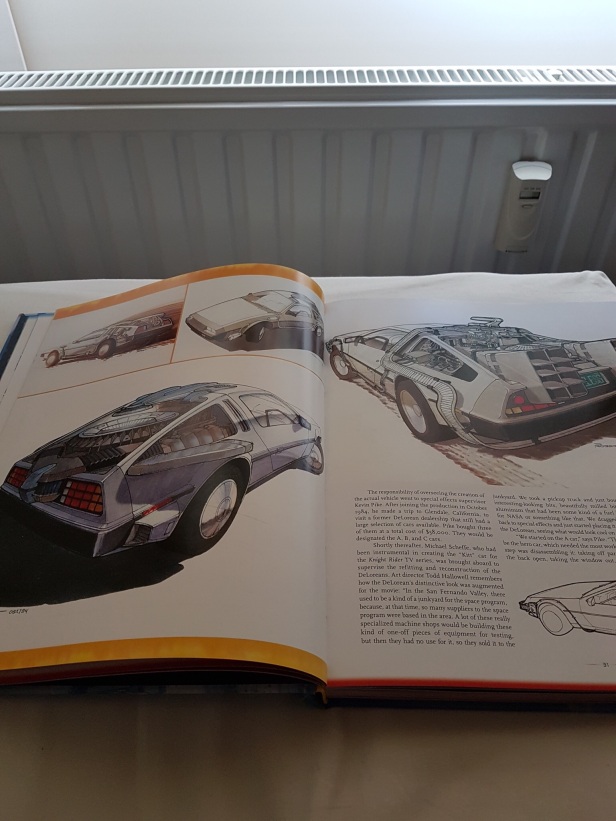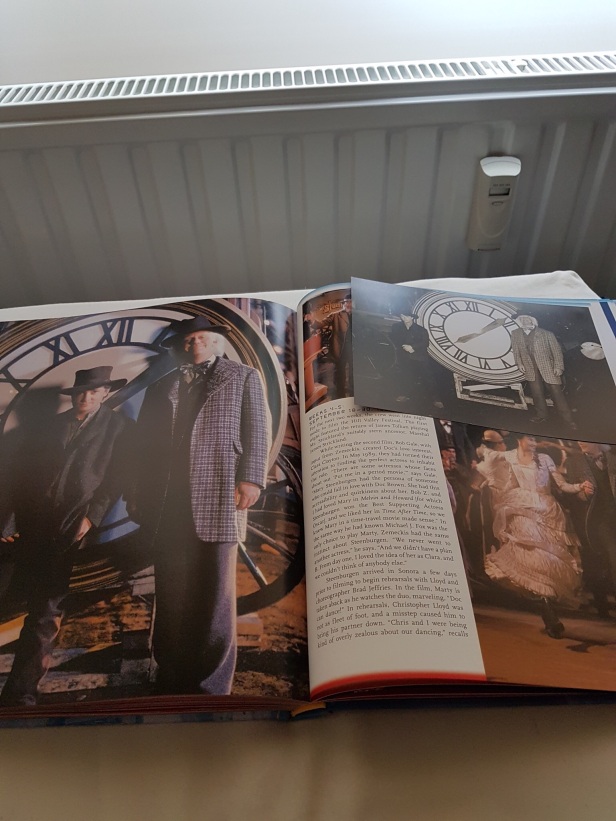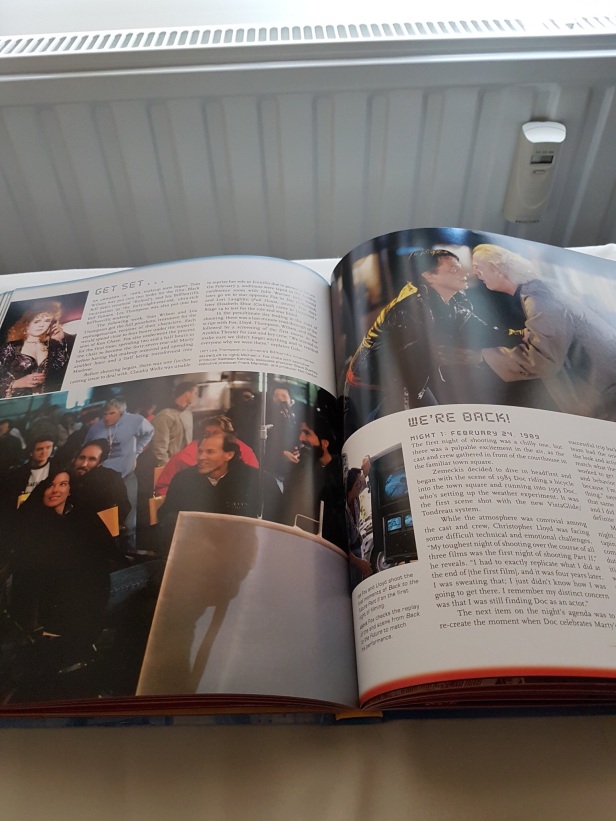In 1985 moviegoing audiences were introduced to one of the best time travelling movies ever made, Back to the Future. The film starring Michael J. Fox and Christopher Lloyd became a huge succes and is one of those classic 80’s movies that pretty much everyone remembers seeing. Eventually a second and third part were released, both also highly succesful movies. I myself regard the Back to the Future movie trilogy as one of the best movie trilogies ever made. It just simply works. The story is great, the characters are pretty much unforgettable, and it contains a ton of sequences that are absolutely amazing to watch. While it is very unlikely that a sequel to these films will ever be made, the franchise still lives on in the hearts of movie lovers all around the world. The year 2015 was not only an important year in the movie itself, but also marked it’s 30th anniversary. A perfect moment to release the book that I am about to review.

The Back to the Future Ultimate Visual History is a book, that chronicles all the aspects involved in making all three movies from the trilogy. It is divided into four main chapters. The first three focus mainly on everything that was needed in order to bring the three movies to the big screen. The final (shorter) chapter, deals with the Universal Studios theme park attraction Back to the Future: the Ride, as well as the short lived Back to the Future animated series. The first three chapters were definitely the most interesting. These contain a wealth of information about the three films, including interviews with the cast and crew, as well as a lot of background stories. How many of you for instance knew that the role of Marty Mcfly was originally played by actor Eric Stoltz? And that he was fired after nearly six weeks of shooting film. Or how much of a pain in the ass actor Crispin Glover, who played the role of Marty’s dad, was on set. It are stories like these, and much, much more that make this book such a joy to read.

But ofcourse it’s not called “the Ultimate Visual History” for nothing. The book comes with a wealth of behind the scenes photographs, production designs, movie posters and other things that make the book a treat for your eyes as well. Also included are a couple of replicas from things that were featured in the film. For instance the photograph from the first movie, that had Marty’s brother and sister slowly fading from the picture. As much fun as these features are, they are also the book’s weakest point. Usually in books like these, the reader is able to remove these things in order to take a closer look at them. Here though, they are glued to the pages of the book, and as such they can’t be taken out without causing damage. Ofcourse I did not remove them, but despite that, because some of them are quite large you do run the risk of causing damage eventually, especially if you want to flip through it’s pages.

But this is a minor issue in what is otherwise a great book. The book is well written and thankfully does not bore you to death with a lot of technical details like which camera techniques were used or stuff like that. The thing I also enjoyed about it were the numerous interviews with the original cast, and also the forewords written by Michael J. Fox and Christopher Lloyd. It is always very cool if you manage to get the actors themselves involved in a project like this as well. All in all I highly recommend this book. Especially if you are a fan of these movies, it provides an interesting background companion to what was involved in the making of these classic films. So all I can say is, let’s go back ….to the future….
I give Back to the Future: the Ultimate Visual History a 9 out of 10 score.


Not 10 out of 10 ? What happened to that one point ?
I did get to see at least one that I’m sure I saw on cable, and though I remember I liked it , I didn’t quite understand the science of the whole time travel thing ( I was too young, I guess ).
LikeLiked by 1 person
Haha, lol, the book would have scored a 10/10 score, if not for the minor issue I adressed with the pictures glued to the pages 😉 Otherwise this book is awesome. I don’t know which part you have seen, but the time travel components can definitely be tricky. Perhaps it’s time for a rewatch of these films: I’m sure you will definitely enjoy them 😊
LikeLike
Looks like a great book to compliment a fantastic series. I pretty much know all of the Back to the Future trivia and have seen the movies countless times. They just never ever get old 🙂
LikeLiked by 1 person
It really was a fantastic book (it made me want to see the entire trilogy again lol), and despite the one flaw I mentioned it has been a great book to read 😊
LikeLiked by 1 person
This sounds like a great accessory to the enhance the experience of loving the movie trilogy. I do love the movies – it’s one of the few cases where I actually remember details despite the time that has passed.
LikeLiked by 1 person
Yes, they are definitely films that you are not likely to forget any time soon 😊 Awesome movies, that will never grow old, no matter how far into the future we will go 😂
LikeLiked by 1 person
This sounds like a pretty awesome book for a collector. Am a big fan of Back to the Future films, they were suc fun films though they could get quite dark as well. I don’t think I would ever get this book as I have too much stuff already, but I can see why a collector and fan would want it. Thanks for sharing
LikeLiked by 1 person
It really was a great book, and a very interesting read as well. I quite often buy books like this (well for movies that I really loved that is), but yeah I also see your point: I most definitely have way too much stuff as well lol 😂😂
LikeLiked by 1 person
we ar collectors. I pity the executor of my estate
LikeLiked by 1 person
Haha lol…😂😂😂 Same here….they might have to appoint more than one executor for me though 😂😂
LikeLiked by 1 person
I love Back to Future. I din’t know about this book. I’ll have to pick up a copy.
LikeLiked by 1 person
So do I. It’s one of my favorite alltime movie series. In fact the book has made me want to see the trilogy again…despite me having lost count on how many times I have seen it already lol 😂 Thank you for your comment 😊
LikeLiked by 1 person
I adore these kinds of books. The making of movies fascinates me, I love all the little things that go into the final product.
LikeLiked by 1 person
Agree, although I hate books that only focus on the technical aspects of a movie…which kind of cameras are featured, which techniques…blah, blah, blah lol 😂 Thankfully this book avoided that 😊
LikeLiked by 1 person
I agree, I like hearing from the screenwriter, stars and director.
LikeLiked by 1 person
Hey. I loved all of your posts and they are amazing and therefore, I nominate you for blue sky tag award
LikeLiked by 1 person
Hello 😊 Wow, thank you so much for this. You are very kind. Really appreciate this 😀
LikeLiked by 1 person
😀😀
LikeLiked by 1 person
Looks like I have missed “the best movie trilogy ever made” 😦 Thanks to your review, I can now look it up to watch 🙂 Did you really read through this whole book? 🙂
LikeLiked by 1 person
Haha, yeah..I read the entire book. It was a real fun read, but also the visual aspects of the book itself were highly enjoyable 😊 Well, I hope you will enjoy the movies. They are amazing and simply a lot of fun to watch 😀
LikeLiked by 1 person
Thanks I do like humor more than horror in my movies 😊 I just watched Zootopia on Netflix. Funny kids movie! The sloth’s reaction to a joke, oh my gosh, slow motion laughs so funny! You should watch 😊
LikeLiked by 1 person
I have heard some pretty positive responses to that one. I’m going to see if it’s available for me here. If so, I might give it watch somewhere this week. Thanks for the recommendation 😊
LikeLiked by 1 person
Alright, I have to admit… I’ve never watched any of the Back to the Future movies… GASP! I know, I know, I’m sorry 😡 I’ve been meaning to for the longest time but never got around to it. I’ll do it soon though!
I love this type of books where you can thoroughly get into the behind the scenes. All of the little details in it sound so great that I’m sure I’d love it even if I haven’t watched any of the movies yet. Of course, a fan will be able to appreciate it a lot more.
Great review! I’m glad you’re getting into reading again ^^
LikeLiked by 1 person
Thank you very much 😀 Did you just hear that sound? It was my jaw hitting the floor from your comment of never having seen these movies. Just kidding ofcourse 😂 It’s hard to keep up with every single movie that was released, so I have missed my own fair share of classic movies 😊 That said these films are amazing, and something I know you will enjoy watching very much. The book was really cool indeed. I loved reading the background for this trilogy, but also the amazing artwork and photographs contained within 😊
LikeLiked by 1 person
Hahaha I’m soooo sorry!! xD I really am one of those people who has not seen that many classics… But I’ve been trying to slowly but surely change that 😉
Indeed! They were really interesting ^^
LikeLiked by 1 person
Lol, no need to apologise, I have missed quite a few classic movies myself, but the great thing is, they aren ‘t going anywhere and you can always watch them at some point 😊
LikeLike
Omg!!!! I need to read this ASAP! 😁 I love your taste in books, anime and movies!!!💖📚🎥🎦📀📺 Awesome Review!🎯
LikeLiked by 1 person
Haha, thanks so much: love your enthusiasm, and your taste is just as good, that is for sure ! 😊 This really was an awesome read. One of the best making off books that I have ever read. Thanks for all these wonderful comments: awesomeness 😀😀
LikeLiked by 1 person
You’re welcome 😊I always interact back with my followers who interact with me!!!😁 You got to share the love!!!💙 Lol! I really enjoy your blog so it’s easy to compliment it!😁
LikeLiked by 1 person
Haha, that is what I do too 😊 It’s one of the best things about blogging I think: meeting all kinds of new and wonderful people and interacting with everyone. I love your blog as well, so it’s not very hard to give compliments there either 😀😀😀
LikeLike
I checked it out like you suggested. It’s awesome! I already knew most of the Back to the Future trilogies history, but it’s still cool to see all the pictures and concept art. My favorite thing about it would be all the loose photographs and important documents that the book comes with. I checked it out at the library, so all that stuff was taped down.😉
LikeLiked by 1 person
So cool that you checked it out 😀😀 I am glad you enjoyed it. As far as making of books go, I own quite a number of them, but this one is certainly one of my favorites 😊😊
LikeLiked by 1 person